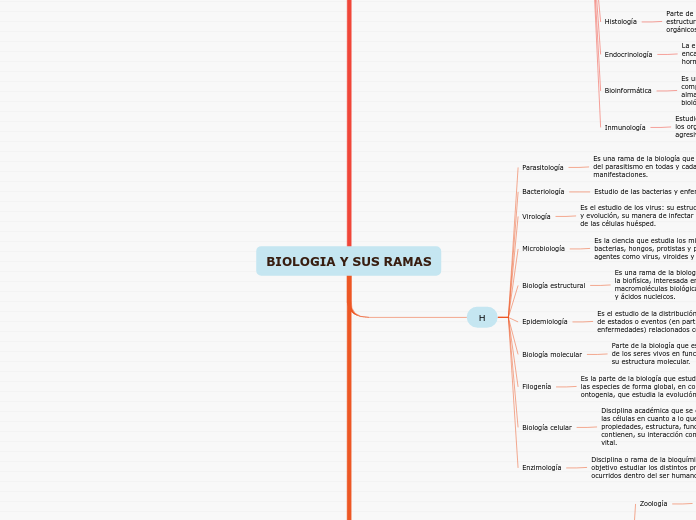por Hensy Arnulfo hace 5 años
667
BIOLOGIA Y SUS RAMAS

por Hensy Arnulfo hace 5 años
667

Ver más

To name your story, you have to think about the overall message and what you want your audience to understand from the story. Also, make it relevant and easy to remember.
The ending of a story is essential. We all know that if the ending is weak, what happened before loses its importance. So make it unpredictable, but fair. A resolved ending answers all the questions and ties up any loose threads from the plot.
Angiosperma y gimnosperma, monocotiledóneas y dicotiledóneas.
Estudio dental en sarcopterigios del período devónico.
Comunicación entre pájaros machos y hembras a través del canto.
Biodiversidad de mamíferos en un dado territorio.
Desplazamiento de las truchas en rios contaminados.
Serpientes, tortugas, iguanas, sapos.
Hormigas, mariposas, abejas.
Ecosistemas de un país.
Zooplancton, fitoplancton, industria pesquera.
Candida albicans, Coccidioides immitis
Monitoreo de los animales en reservas nacionales.
The middle of the story is where you add layers of complications that will lead to the end. Reveal more about the character's journey. Did their personality go through changes? How did they overcome the challenges? And as you build up the story’s central conflict, make it more personal to that character. Also, from the middle act, you have to lead into the final act.
Hexokinasa, enzima que fosforila la glucosa en el primer paso de la glicólisis.
Diferencias de nucleótidos en el gen del citocromo c entre el ser humano y el chimpancé.
Factores de transcripción (proteínas) que se unen a secuencias nucleotídicas (ADN) de genes específicos.
Predicción de la propagación de una enfermedad según el nivel de contagio.
Subtopic
Estructura de la proteína miosina en el músculo cardíaco.
Bacterias, arqueas, hongos, protozoarios y virus.
Coronavirus, retrovirus, influenza
There wouldn't be any tension and excitement in your story if there weren't any obstacles in your character's way.
A story is nothing more than a character overcoming a series of difficulties to reach the desired goal. Obstacles usually create suspense and conflict. In overcoming obstacles, there is growth: weak becomes strong; hatred turns into love; sadness into happiness; wrong into right; lies into truth; or evil becomes good.
See a few examples below:
Salmonella sp., Neisseria meningitidis
Each story has a main character and that character usually needs to solve a problem or challenge. The character's challenge is the one that creates tension throughout the story.
Type in any other challenges which other characters in the story need to face.
El parásito intestinal Taenia saginata.
In the beginning of the story (or the exposition), you will need to introduce the setting and characters. You might also want to introduce the main conflict. This part of the story is important because it gives the reader necessary background information and maybe even a first insight into a character’s personality.
Linfocitos T y anticuerpos
Arboles filogenéticos, homología de proteínas
Páncreas e insulina en la diabetes tipo 1 y 2.
Biopsias de tejidos.
Dominio, reino, fila, clase, orden, familia, género, especie.
Mutaciones, polimorfismos genéticos, enfermedades ligadas al sexo.
Potencial de acción de la neurona.
Los colibrís antes tenían el pico pequeño pero como las plantas evolucionaron ellos también lo tuvieron que hacer.
Migraciones de las aves; rituales de apareamiento de animales.
Efecto del consumo de alcohol en el desarrollo embrionario del ser humano.
Células epiteliales, linfocitos, monocitos.
The setting (time & place) of a story can change throughout the plot.
Your story can take place wherever your imagination will take you to.
For example: in an elevator, in an enchanted forest, etc. Don't forget to give details of the environment each time the setting changes, otherwise, the story can be confusing. Also, mention the seasons as each of them has unique weather and events.
Glicólisis, glucogenogénesis, fermentación láctica.
Characters are essential to a good story. Usually, the protagonist(s) is/are the most affected by the plot. Introduce a character by focusing on their actions, interests, and occupation, as the physical appearance doesn't make a difference in most cases.
Type in the name of your character.
Localización de la vena femoral en el ser humano.
Add other properties of the character.